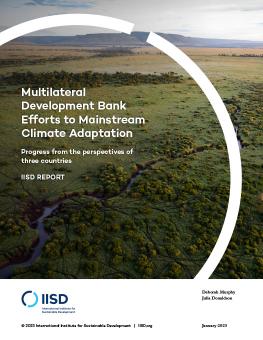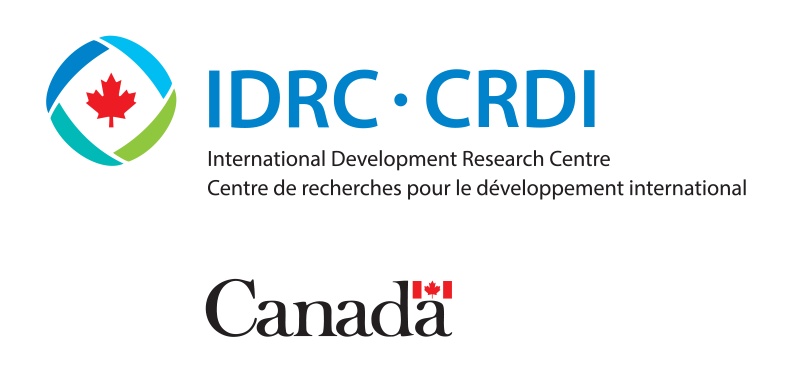
Multilateral Development Bank Efforts to Mainstream Climate Adaptation
Progress from the perspectives of three countries
Multilateral development banks (MDBs) are expected to play a critical role in closing the gap between the volume of finance needed by developing countries to prepare for climate change and the amount of funding they currently have available. They have committed to increasing their financing for climate adaptation as well as aligning their country portfolios with the adaptation priorities of developing country governments. This paper explores the progress of four MDBs—the African Development Bank, the Asian Development Bank, the Inter-American Development Bank, and the World Bank—on meeting their adaptation finance commitments based on the experiences of Kenya, Nepal, and Peru.
-
Between 2013 and 2020, the total amount of adaptation-related financing provided by the World Bank to Nepal amounted to USD 1,197.8 million, compared to USD 453.6 million in financing for projects with mitigation co-benefits.
-
MDBs have increased their use of climate risk screening and assessment since 2013, which appears to have increased the proportion of project budgets determined to have adaptation co-benefits.
-
MDBs are beginning to establish processes to align their financial flows with developing country governments' adaptation priorities set out in National Adaptation Plans and nationally determined contributions.
Specifically, this report explores the progress made by MDBs to
- Scale up finance for adaptation at the country level across the full breadth of their investment portfolio, including designated climate finance and development finance streams.
- Incorporate climate risk screening and assessment in project design and implementation.
- Align their portfolios with adaptation priorities identified by national governments in their National Adaptation Plans (NAPs) and nationally determined contributions (NDCs).
Drawing upon case studies prepared by three research organizations—the African Centre for Technology Studies based in Kenya, the Prakriti Resources Centre based in Nepal, and Libélula based in Peru—the paper’s key findings are:
- The four MDBs examined have increased their flows of finance for adaptation over the past decade at the global level. At the country level, the reviews of finance for adaptation provided by these MDBs in Kenya, Nepal, and Peru indicate that while they are generally increasing, it is difficult to discern clear trends.
- Screening for and assessing climate change vulnerability and risk have become standard practices with most MDBs, with an observed increase in the number of projects now being assessed for climate risk in the design and implementation stages. It is likely that this allocation of upfront funding to assess climate risks, particularly for large infrastructure investments, has led to an increase in the proportion of project budgets tagged by the MDBs as having adaptation co-benefits.
- MDBs are beginning to draw on information in national documents—such as NAPs and NDCs—to guide their programming and project identification at the country level.
Despite this progress, the paper highlights ongoing challenges in scaling up MDB finance for adaptation. Among these challenges is a lack of transparency in how allocations of finance for adaptation are determined at the project level. Finance ministries also need a greater understanding of the economic case for and benefits of adaptation, as well as the need to mainstream adaptation in national economic development strategies and budgets. Consequently, scaling up finance for adaptation in developing countries like Kenya, Nepal, and Peru will require continued MDB support for technical analysis and country-led climate adaptation planning processes.
The paper concludes that MDBs could also place greater emphasis on funding discrete adaptation projects, in addition to financing the additional costs of ensuring that climate risks are reduced in the design and implementation of development projects. It also calls for consideration to be given to programmatic finance for adaptation and utilization of a wider range of financial instruments to support long-term adaptation programs. These efforts should be anchored in an ongoing commitment to using countries’ NAPs and NDCs to identify the best and most strategic use of MDB climate and development finance.
Participating experts
You might also be interested in
Guiding Principles for the Preparation of Financing Strategies for Climate Change Adaptation in Developing Countries
This report provides seven guiding principles for effective financing strategies for climate change adaptation prepared by developing country governments.
Alignment: A key element of successful financing strategies for climate change adaptation
This brief explores the need for, benefits of, and strategies to align developing countries' financing strategies for adaptation with other national financing strategies.
Innovative Financial Instruments and Their Potential to Finance Climate Change Adaptation in Developing Countries
This report explores the range of innovative financial instruments that could be used to scale up financing for adaptation and lessons for their use in developing countries.
Preparing Financing Strategies for Adaptation: Emerging good practices
Amid a growing interest in the preparation of financing strategies for adaptation, new research aims to unpack what the scope of these strategies should entail, what constitutes good practices for their development, and whether these strategies are truly effective.
